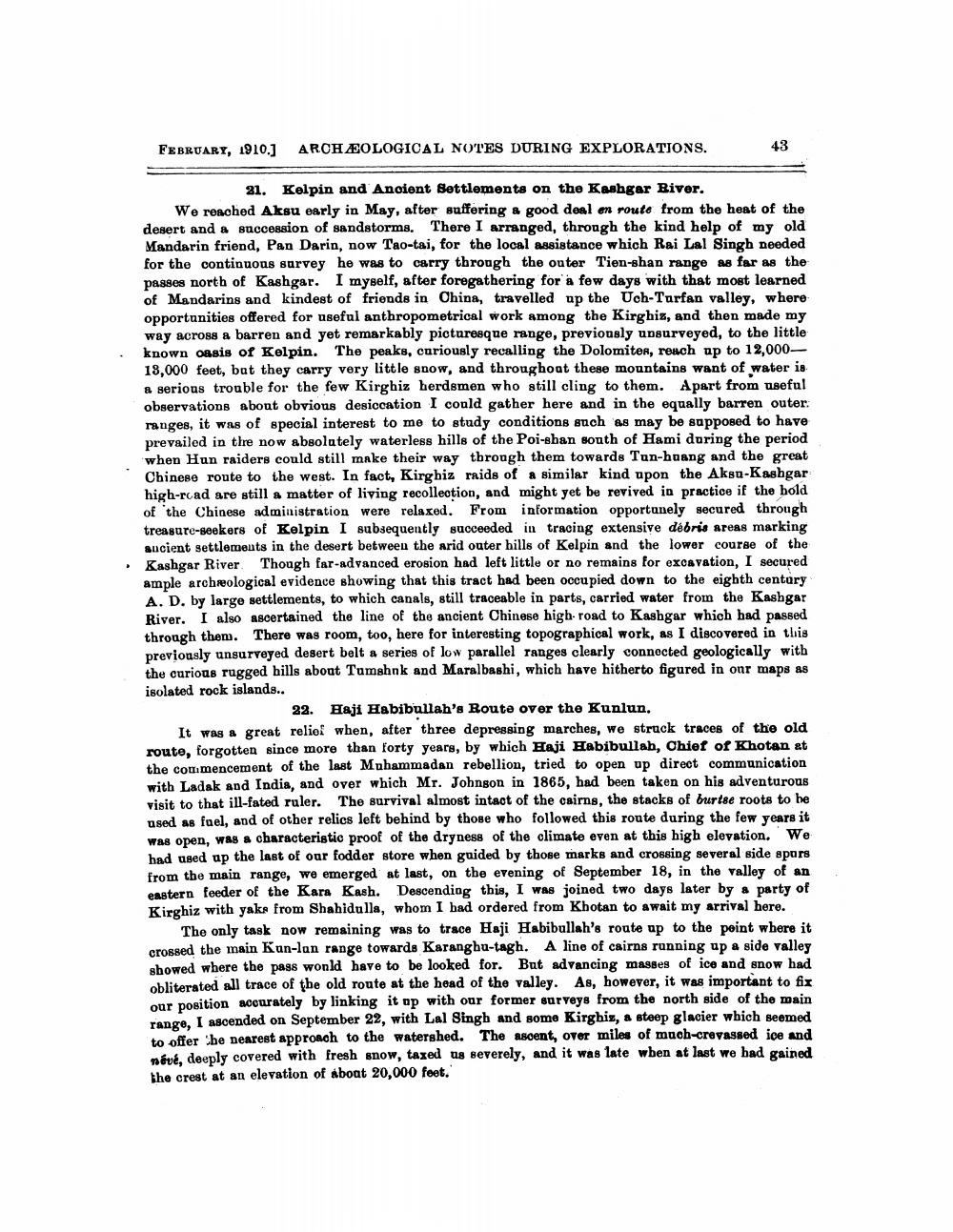________________
FEBRUARY, 1910.) ARCHÆOLOGICAL NOTES DURING EXPLORATIONS.
43
21. Kelpin and Ancient Settlements on the Kashgar Biver. We reached Aksu early in May, after suffering & good deal en route from the heat of the desert and a succession of sandstorms. There I arranged, through the kind help of my old Mandarin friend, Pan Darin, now Tao-tai, for the local assistance which Rai Lal Singh needed for the continuous survey he was to carry through the outer Tien-shan range as far as the passes north of Kashgar. I myself, after foregathering for a few days with that most learned of Mandarins and kindest of friends in China, travelled up the Uch-Tarfan valley, where opportunities offered for useful anthropometrical work among the Kirghiz, and then made my way across a barren and yet remarkably picturesque range, previously unsurveyed, to the little known oasis of Kelpin. The peaks, curiously recalling the Dolomites, reuch up to 12,000 13,000 feet, but they carry very little snow, and throughout these mountains want of water is a serious trouble for the few Kirghiz herdsmen who still cling to them. Apart from useful observations about obvious desiccation I could gather here and in the equally barren outer. ranges, it was of special interest to me to study conditions such as may be supposed to have prevailed in the now absolutely waterless hills of the Poi-shan south of Hami during the period when Hun raiders could still make their way through them towards Tun-huang and the great Chinese route to the west. In fact, Kirghiz raids of a similar kind upon the Aksu-Kashgar high-road are still a matter of living recollection, and might yet be revived in practice if the bold of the Chinese administration were relaxed. From information opportunely secured through treasure-seekers of Kelpin I subsequently succeeded in tracing extensive débris areas marking ancient settlements in the desert between the arid outer hills of Kelpin and the lower course of the Kashgar River Though far-advanced erosion had left little or no remains for excavation, I secured ample archeological evidence showing that this tract had been occupied down to the eighth century A. D. by large settlements, to which canals, still traceable in parts, carried water from the Kashgar River. I also ascertained the line of the ancient Chinese high road to Kashgar which had passed through them. There was room, too, here for interesting topographical work, as I discovered in this previously unsurveyed desert belt a series of low parallel ranges clearly connocted geologically with the curious rugged hills about Tumshnk and Maralbashi, which have hitherto figured in onr maps as isolated rock islands..
32. Haji Habibullah's Route over the Kunlun. It was a great relief when, after three depressing marches, we struck traces of the old route, forgotten since more than forty years, by which Haji Habibullah, Chief of Khotan at the commencement of the last Muhammadan rebellion, tried to open up direct communication with Ladak and India, and over which Mr. Johnson in 1865, had been taken on his adventurous visit to that ill-fated ruler. The survival almost intact of the cairns, the stacks of burtse roots to be used as fuel, and of other relics left behind by those who followed this route during the few years it was open, was a characteristic proof of the dryness of the climate even at this high elevation. We had used up the last of our fodder store when guided by those marks and crossing several side spars from the main range, we emerged at last, on the evening of September 18, in the valley of an eastern feeder of the Kara Kash. Descending this, I was joined two days later by a party of Kirghiz with yaks from Shahidulla, whom I had ordered from Khotan to await my arrival here.
The only task now remaining was to trace Haji Habibullah's route up to the point where it crossed the main Kun-lan range towards Karangbu-tagh. A line of cairns running up a side valley showed where the pass wonld have to be looked for. But advancing masses of ice and snow had obliterated all trace of the old route at the head of the valley. As, however, it was important to fix our position accurately by linking it op with our former surveys from the north side of the main range, I ascended on September 22, with Lal Singh and some Kirghiz, a steep glacier which seemed to offer the nearest approach to the watershed. The ascent, over miles of muoh-crevassed ice and névé, deeply covered with fresh snow, taxed us severely, and it was late wben at last we had gained the crest at an elevation of about 20,000 feet.




